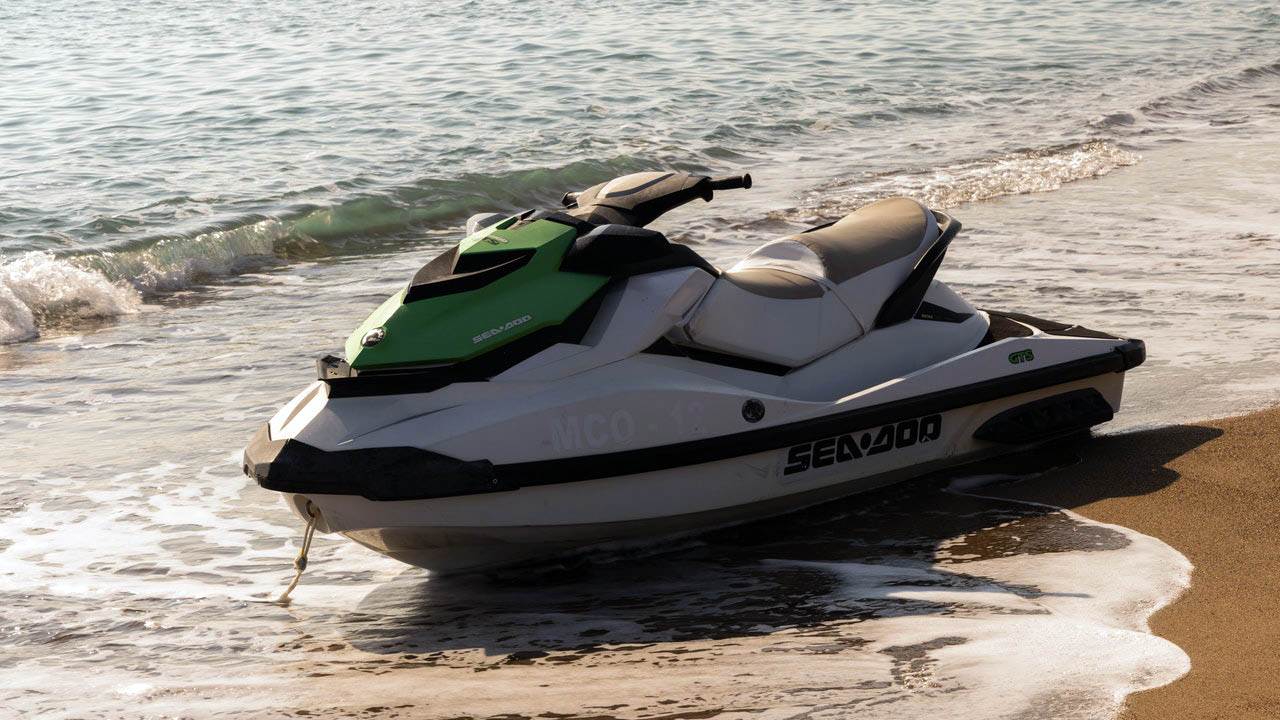7 Reasons Why Jet Ski Sink (How to Prevent?)
Jet skiing is a thrilling and adrenaline-pumping water sport that is both fun and a great source of exercise, so it’s no wonder why you may want a jet ski of your own. If you’re planning to purchase a jet ski, you must understand how to take care of it and the reasons why it might sink.
The main reason why your jet ski can sink is due to missing or damaged drain plugs. Other reasons include collisions, frequently riding your jet ski in shallow water, using an improper towing method, poor maintenance of your jet ski, deliberate mishandling, and leaving your jet ski in the water for too long, all of which damage your watercraft.
Though we know the main reasons why jet skis may sink, there are still plenty of things to consider for each reason, such as why, in the first place, missing drain plugs can sink your watercraft. To help you learn more about why jet skis sink, how to prevent them from sinking, and what to do if they do sink, let’s look into jet skis in detail.
Top 7 Reasons Why Jet Skis Can Sink
There are several reasons why a jet ski can sink, and plenty of those reasons are due to human error and mishandling the jet ski.
Issues With Drain Plugs
The most common reason jet skis can sink is due to missing drain plugs. A jet ski has drain plugs to ensure that you can drain the water from the bilge after you use the jet ski. Unfortunately, some people forget about putting the drain plugs back in place after draining the water, meaning water can enter the hull and cause the jet ski to sink.
Furthermore, most jet skis tend to have at least two drain plugs, and some people may only remember to put back one drain plug instead of the full set. After placing the jet ski back into the water, enough water will eventually get into the hull.
Another issue with drain plugs is that they can wear out or receive damage over time. Even if you ensure that the drain plugs are put back into the jet ski, they may not be in securely enough to prevent water from entering the jet ski.
Collisions
Colliding with anything that can cause damage to your jet ski can end up causing it to sink, depending on what you collide with. If you end up hitting a sharp piece of rock, it can puncture the jet ski and cause water to seep into the watercraft, eventually causing it to sink.
If you collide with other waterborne vessels, certain parts of your jet ski can receive damage. It could get scratches, cracks, and leaks that will let water into the watercraft and cause it to fill up with enough water to sink.
Riding Frequently in Shallow Water
You can ride most types of jet skis in as little as six inches of water. However, if you continue riding too close to the shoreline or if you frequently ride in shallow waters, the jet ski can scrape against sharp or rough objects in the sand and thus eventually cause cracks in the hull, leading to your jet ski sinking.
Wrong Towing Method
If you do not tow your jet ski with the correct handling methods, it can lead to engine damage and fill it with water. If you tow your jet ski over five miles per hour, it may let water in through the exhaust ports and flood the cylinders, eventually causing your jet ski to sink.
Poor Maintenance of Your Jet Ski
Jet skis require proper maintenance for you to safely use and drive the watercraft in the long run. Without regular maintenance, it can lead to you not discovering damages early and letting issues fester until your jet ski sinks. Issues can include the presence of small, unnoticeable cracks that let in a lot of water over time.
Wave Jumping (and Other Improper Handling)
Wave jumping refers to when you use your jet ski to jump over waves, and while it may be entertaining, it can severely damage your watercraft in the long run and can even endanger other people in the area. Wave jumping can lead to wide cracks on the hulls and even broken engine mounts, eventually sinking your jet ski.
Moreover, you can improperly handle your jet ski by driving it at overly high speeds. Not only can it be dangerous for yourself and for other people, but it can also damage your jet ski. If you drive it at high speeds, contact or collision with pretty much anything can lead to cracks or even worst consequences.
Leaving Your Jet Ski in the Water for Too Long
It is best practice to take out your jet ski from the water after you use it, lest it eventually damages the jet ski. For example, if you leave your jet ski in the water and a few strong waves hit the watercraft, the impact can eventually cause your jet ski to hit things around it, leading to punctures and cracks that can cause it to sink.
If you leave your jet ski in seawater for long periods of time, it can also lead to corrosion, depending on the quality of the jet ski. After the metallic areas corrode, it can result in water leaking into the jet ski and thus ultimately sinking.

How to Prevent My Jet Ski From Sinking
Just as there are plenty of reasons for jet skis to sink, there are also a lot of different measures you can put in place to prevent the issue from occurring in the first place. One is by putting your jet ski through general maintenance regularly.
Installing a Bilge Pump
A bilge pump is a water pump that can pump out water from your jet ski. With a bilge pump, you won’t have to face the issue of forgetting to replace your drain plugs, as the bilge pump can empty all of the water that gets into the bilge.
Proper Maintenance
A preventative measure to stop your jet ski from sinking is conducting thorough engine checks before each time that you set out with your jet ski. Checking your engine is part of the regular maintenance you should perform each time you ride out.
If you check your engine regularly, you can ensure that there are no engine damage and no water seeping into the engine. Finding such a problem with your engine can thus contribute to preventing your boat from sinking.
Proper maintenance also includes a visual inspection of your jet ski. You should conduct a visual inspection before each time you get on the jet ski so that you can identify problems before exposing your jet ski to water.
Inspecting the watercraft can help you notice cracks and breaks that can lead to water damage and the jet ski sinking. Along with checking your jet ski every time you use it, you should also make sure to perform visual inspections every year to spot any current or potential issues.
Handling Your Jet Ski Safely
While this may be common sense, many jet ski accidents still occur due to improper handling of jet skis and general recklessness. Take care not to drive too fast, be aware of all the people, objects, and rough surfaces around you, and refrain from pulling dangerous tricks such as wave jumping.
Another way to ensure that you safely handle your jet ski is to refrain from driving in shallow water. Other than potentially driving over rough areas, it can also cause it to become stuck and collect small remnants of things in the sand, damaging your jet ski over time and eventually leading to enough damage to let in seawater and sink your jet ski.
You should also make sure to maintain a safe distance away from anyone else in the water. Keeping a reasonable distance can help you prevent collisions with other boaters, thus avoiding damage to your watercraft.
Use the Correct Jet Ski Towing Method
Since using an improper towing method can lead to damages that can cause your jet ski to sink, then towing your jet ski using the proper method can prevent the issue in the first place. In order to tow your jet ski properly, you must drive slowly at less than six miles per hour and apply steady pressure to your breaks.
Remove the Jet Ski From the Water
When you are not using the jet ski, you should remove it from the seawater and store it in an appropriate place. In general, a jet ski runs for about 40 hours per year, meaning that it should not be in the water most of the time to prevent corrosion and other damages.
An example of an appropriate location to store your jet ski after removing it from the water is in a normal garage. If you keep your jet ski semi-close by, you can quickly and easily carry out maintenance for your jet ski, perform any checks, and clean your watercraft periodically. You can also notice and fix leaks quicker.

What Do You Do After a Jet Ski Sinks?
If your jet ski sinks anyway, even with preventative measures in place, there are still things you can do to help reduce the negative impact of your jet ski sinking. Firstly, if you are in a more remote area at sea, use a flare or VHF radio to call for help to get you out of any dangerous situations.
Once you and your jet ski are both out of the water, make sure that you remove all of the liquid in the engine to prevent it from causing further damage. Drain the water from other jet ski parts using a bilge pump or removing the drain plugs.
After draining as much water as you can from inside your jet ski, you must try to get it back on the water within the next few hours of it sinking. Get it running across the water as it can help to ensure your engine works and that it has not received too much damage by taking in a lot of seawater.
Conclusion

Overall, there are plenty of reasons jet skis may end up sinking, including mishandling, collisions, damage to the jet ski, and more. To prevent you from having to deal with a sunken jet ski in the first place, use the guide above to put preventative measures in place to keep your jet ski in top condition.

